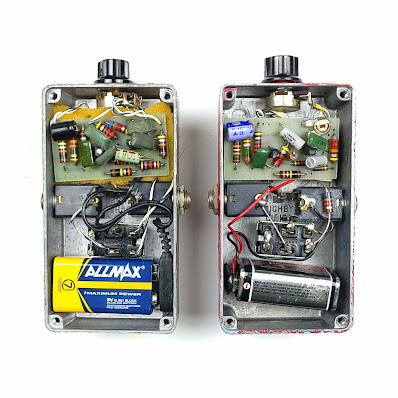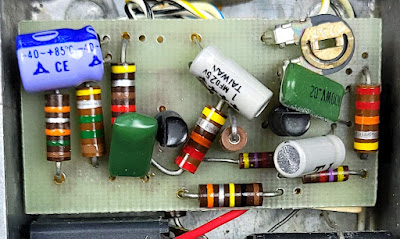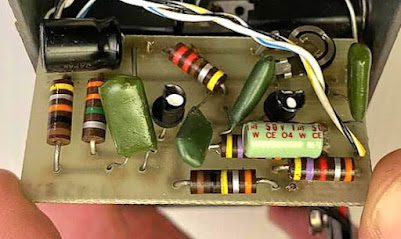☟
12 years ago I found a mysterious red pedal while sifting through ebay at 1am. I had no clue what it was, but the inside looked fuzz-esque so I went for it... After a few months of digging and extensive internet chatroom debates, I realized that I had actually stumbled upon an original Sam Ash Fuzz-Stainer; an insanely rare pedal from the early to mid-70s. If you've followed this blog for a while you may have come across the first article I wrote on that very pedal shortly after figuring out what it was. (HERE'S THE LINK)
Well, after this discovery I sent it off to the incredibly talented pedal-builder Jerms, who traced and cloned it for me. (maybe some of you are lucky enough to own one of his copies?)
Later on we both decided to make his schematic public; so I went back and added Jerms' work to the end of my article. Shortly afterwards the diy pedal scene exploded with Fuzz-Stainer clones! And while I was initially surprised at the reaction, this is pretty typical for discoveries of any "new" circuits that have been hiding in almost complete obscurity for the past 30+ years.
Since then I only knew of one other original unit that existed, owned by Matt Wright of Wright Sounds. He had one for over a decade and ended up cloning it and releasing his version in 2010 as the Fuzz-Stang.
Well, after 12 long years of hunting, searching, and scouring, I have finally found a 3rd Sam Ash Fuzz-Stainer!
And while I was hoping to finally crack the code of the exact history of these pedals, I now have even more questions...
We still do not know (even after reaching out to the Ash family) just how or why these exist. We don't know when they were sold, how many were made, which stores they were available in, who invented/built them, etc.
So hopefully at some point in the future more info will begin to pour in. But what we can do now, at the very least, is look at the 3 existing units and compare them:
The first thing I noticed is that the same pcb was used for all 3 pedals. And for the most part, it is the same effect in each. But there are definitely differences between them, some more glaring than others.
For a while I thought that my red pedal, since it was missing the original label, was most likely an updated version of the circuit; a "Mark III" possibly. And my main reasoning was based on the open holes in the pcb and the internal trimpot. It's easy to see this and conclude that there must have been an update to the circuit design at some point.
And if you look at my new Fuzz-Stainer, that conclusion seems even more plausible, as it's clearly the same pcb but with components in every slot and no trimpot in sight...
But here's where it gets really interesting; the 3rd unit seems to be a hybrid of the other two, and the board is facing downward!!!
AND it's labeled as "Mark II", just like my newer unit. Which leads me to believe that all three pedals were "Mark II" Fuzz-Stainers.
So then the question becomes, why were all three made differently? Was there a "Mark I" of the circuit? Were these possibly kits of some kind? Did Sam Ash have a pedal building class and this was the project? Or was each pedal really just built to sound its best based on the available components at the time, regardless of consistency?
Well, as you can see there is literally a ton of information that's still very unknown about these. Obviously they came from Sam Ash (who, until this pedal, had outsourced all other branded gear to a 3rd party manufacturer). At least two of these have stories from original owners who remember buying them from the legendary 48th St. Sam Ash in NYC. And they are most likely from the early to mid 1970s.
But other than what we've touched on above, I got nothing! We've reached out to members of the Ash family, who have kept meticulous records and paperwork all these years, but as of yet no mention of the Fuzz-Stainer anywhere.
So if you happen to come across this article and happen to own, have owned, or know anything about the Sam Ash Fuzz-Stainer, please contact me via
EMAIL or
INSTAGRAM. I would love to hear from you.
Thanks for reading,
-ed

















